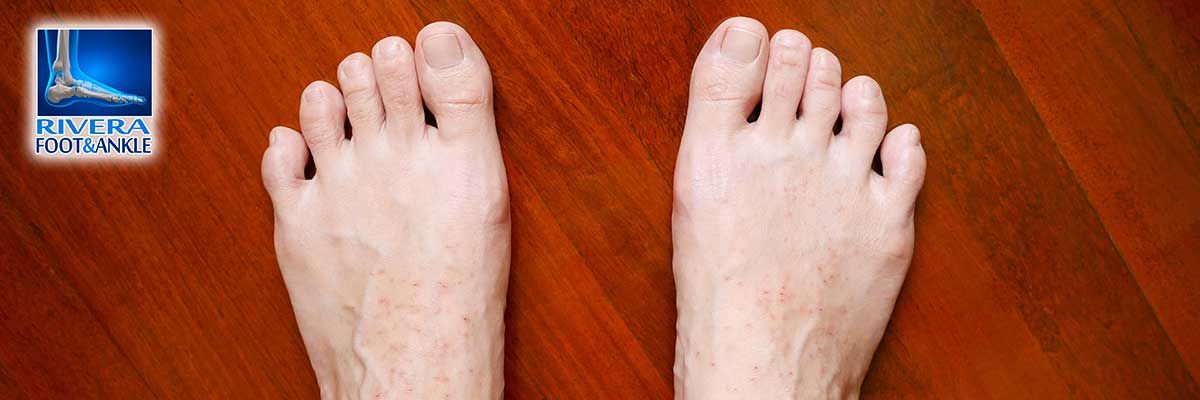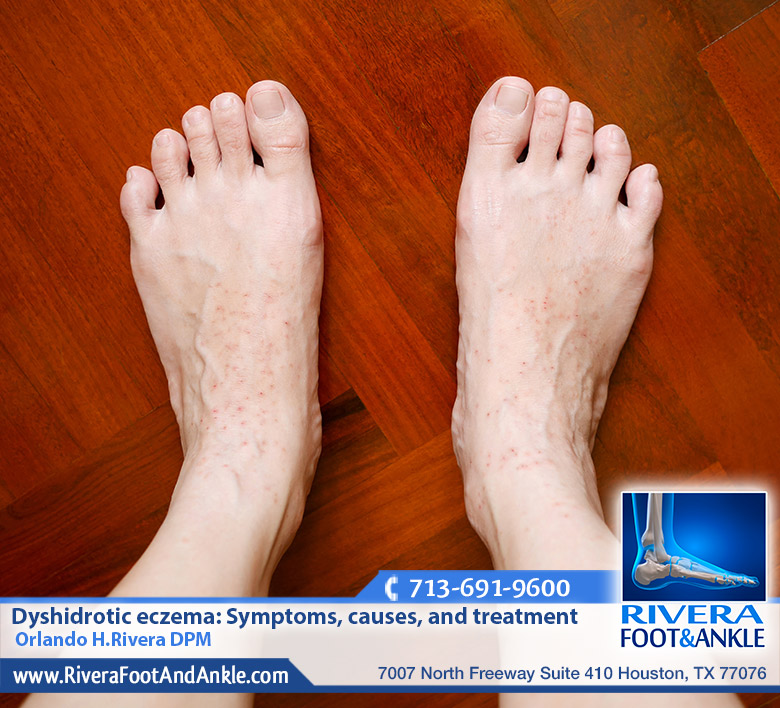
Orlando H.Rivera DPM
Dyshidrotic eczema: Symptoms, causes, and treatment
Overview
Dyshidrotic eczema, or dyshidrosis, is a skin condition in which blisters develop on the soles of your feet and/or the palms of your hands.
The blisters are usually itchy and may be filled with fluid. Blisters normally last for about two to four weeks and may be related to seasonal allergies or stress.
What causes dyshidrotic eczema?
The exact cause of dyshidrotic eczema is unknown. Experts believe that the condition may be related to seasonal allergies, such as hay fever, so blisters may erupt more frequently during the spring allergy season.
Who is at risk for developing dyshidrotic eczema?
Doctors believe that you have a greater chance of developing the condition if you’re experiencing a high level of stress (either physical or emotional) or have allergies. Some doctors think that dyshidrotic eczema may be a type of allergic reaction.
You may be more likely to develop dyshidrotic eczema if your hands or feet are often moist or in water, or if your work exposes you to metal salts, such as cobalt, chromium, and nickel.
Dyshidrotic eczema in children
Eczema, or atopic dermatitis, is more common in children and infants than in adults. About 10 to 20 percent have some form of eczema. However, half will outgrow atopic dermatitis or eczema by adulthood.
Conversely, dyshidrotic eczema can affect children, but it’s usually seen in adults ages 20–40.
Symptoms of dyshidrotic eczema
If you have dyshidrotic eczema, you’ll notice blisters forming on your fingers, toes, hands, or feet. The blisters may be more common on the edges of these areas and will probably be full of fluid.
Sometimes, large blisters will form, which can be particularly painful. The blisters will usually be very itchy and may cause your skin to flake. Affected areas may become cracked or painful to the touch.
The blisters may last up to three weeks before they begin to dry. As the blisters dry up, they’ll turn into skin cracks that may be painful. If you’ve been scratching the affected areas, you may also notice that your skin seems thicker or feels spongy.
How is dyshidrotic eczema treated?
There are a number of ways that a dermatologist can treat dyshidrotic eczema. The severity of your outbreak and other factors determine which treatments they will suggest. It also may be necessary to try more than one treatment before finding the right one for you.
Medications or medical treatments
For mild outbreaks, medications include corticosteroid cream or ointment that you apply directly to your skin. For more severe outbreaks, you may be prescribed a topical steroid, steroid injection, or pill.
Other medical treatments used are:
- UV light treatments
- draining large blisters
- antihistamines
- various anti-itch creams
- immune-suppressing ointments, such as Protopic and Elidel (this is a rare treatment option)
- If your skin becomes infected, then you will also be prescribed antibiotics or other medications to treat the infection.
Home treatments
Soaking your hands and feet in cool water or applying wet, cold compresses for 15 minutes at a time, two to four times a day, can help reduce the discomfort associated with itchy skin.
Your doctor may recommend that you apply an ointment or rich moisturizer after you use compresses. A moisturizer may also help with the dryness, and therefore reduce some itching as well.
These moisturizers may include:
- petroleum jelly, such as Vaseline
- heavy creams, such as Lubriderm or Eucerin
- mineral oil
- soaking with witch hazel
Diet
Changing your diet may help if medications don’t seem to be keeping up with flare-ups. Since it is believed that a nickel or cobalt allergy can cause eczema, removing foods that contain these may help.
Some have said that adding vitamin A to your diet will help, but be sure to ask your doctor before doing so.
Treatment for feet
Dyshidrosis can also occur on the soles of your feet, although it’s not as common as on your fingers or the palms of your hands. The treatment for your feet is similar to the treatment for other areas.
To avoid making your pain and itching worse, try not to scratch or break your blisters. Although it’s important to wash your hands regularly, you may want to avoid extensive contact with water, such as frequent hand-washing.
You should also avoid using products that can irritate your skin, such as perfumed lotions and dishwashing soap.
RIVERA FOOT & ANKLE: At Orlando H.Rivera DPM, our priority is to deliver quality care to informed patients in a comfortable and convenient setting. When you have problems with your feet, you need to turn to a podiatrist who listens and responds… an experienced doctor who knows the field and can effectively diagnose and treat your needs… a friendly physician who counsels you on the best ways to maintain and improve your health. Our physician(s) meet all these criteria. Plus, you benefit from a dedicated team of trained professionals who give you the individualized attention you deserve.

Orlando H.Rivera DPM
Foot and Ankle, Dr. Orlando Rivera, Advanced Foot & Ankle Specialist, Foot and Ankle Podiatry, Houston Foot & Ankle Surgical, Treatment of Foot and Ankle, Foot & ankle specialists, Podiatrist in houston, podiatrist in houston, Orlando H.Rivera DPM, Houston Foot Doctor, Foot and Ankle Surgeon Houston, Ankle and Foot Specialist Houston, Podiatrist Houston, Foot Pain Houston.



